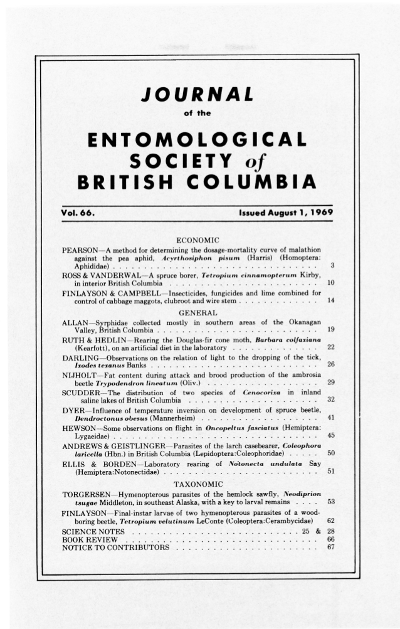A spruce borer, <i>Tetropium cinnamopterum</i> Kirby, in interior British Columbia
Keywords:
spruce borer, <i>Tetropium cinnamopterum</i>Abstract
A spruce borer, <i>Tetropium cinnamopterum</i> Kirby, is an important borer in logs of spruce, <i>Picea</i> spp., in British Columbia. The L-shaped larval galleries penetrated to depths of 52 mm in the sapwood, and ranged from 26 to 90 mm in length; their average volume was 0.81 cc. Captive adults lived for about 2 weeks and deposited up to 155 eggs per female. Eggs hatched in about 12 days; the larvae fed under the bark for about 8 weeks before boring into the xylem of spring-felled logs. Possible control measures based on this investigation of the borer's life history and larval development are considered briefly.References
Blatchley, W.S. 1910. An illustrated descriptive catalogue of the Coleoptera or beetles known to occur in Indiana. The Nature Publishing Co., Indianapolis, Indiana 1386 p.
Craighead, F.C. 1923. North American cerambycid larvae. Canada Dept. Agric. Bull. 27 N.S. (Technical), 226 p.
Richmond, H.A. and R.R. Lejeune. 1945. The deterioration of fire-killed white spruce by wood-boring insects in Northern Saskatchewan. For. Chron. 21:168-192.
Ross, D.A. 1967. The western larch borer, Tetropium velutinum LeConte in Interior British Columbia. J. Entomol. Soc. Brit. Columbia, 64:25-28.
Ross, D.A. and N.J. Geistlinger. 1968. Protecting larch logs from Tetropium velutinum LeConte with lindane emulsion. J. Entomol. Soc. Brit. Columbia, 65:14-15.
Downloads
Published
Issue
Section
License
Authors who publish with the Journal of the Entomological Society of British Columbia agree to the following terms:
-Authors retain copyright and grant the journal right of first publication with the work simultaneously licensed under a Creative Commons Attribution License that allows others to share the work with an acknowledgement of the work's authorship and initial publication in this journal.
-Authors are able to enter into separate, additional contractual arrangements for the non-exclusive distribution of the journal's published version of the work (e.g., post it to an institutional repository or publish it in a book), with an acknowledgement of its initial publication in this journal.
-Authors are permitted and encouraged to post their work online (e.g., in institutional repositories or on their website) prior to and during the submission process, as it can lead to productive exchanges, as well as earlier and greater citation of published work (See The Effect of Open Access).


